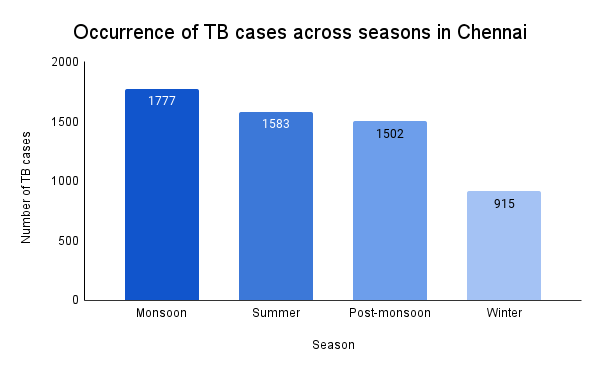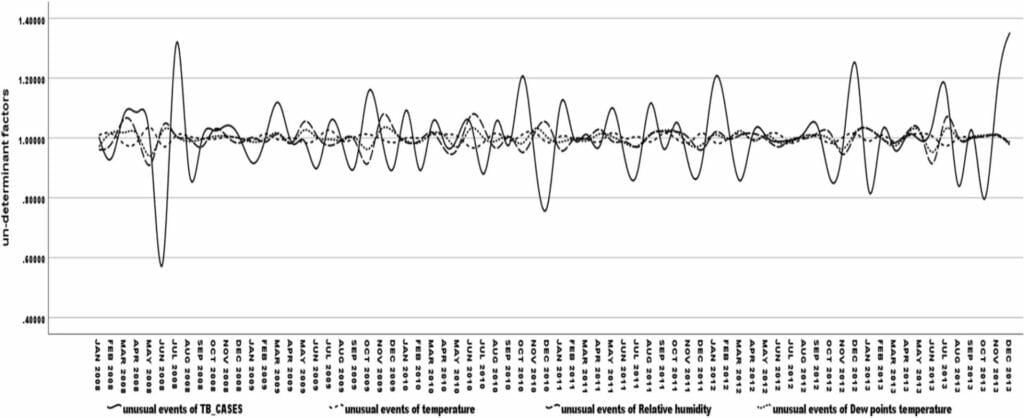If you have friends and family in other parts of India, you may hear them say, “It is too hot and humid there. I do not want to come to Chennai.” Well, Chennai’s heat and humidity may not tempt tourists, but it is certainly attractive enough for tuberculosis (TB) bacteria to thrive.
With climate change staring the city in its face, the risks Chennai runs are not just environmental but have far-reaching implications on health. Could climate change also lead to an explosion of TB cases in the city? How can we protect ourselves from such possibilities?
When does TB peak in Chennai?
ICMR-National Institute for Research in Tuberculosis (NIRT) studied how heat and humidity affected tuberculosis occurrence in Chennai. They used the data of daily TB cases from the National Tuberculosis Elimination Program centres in Chennai from 2008 to 2015. There were 5777 TB cases reported during that period.
Secondly, they also collected corresponding daily climatic data from the Regional Meteorological Centre in Chennai.
The findings indicate that TB cases in Chennai have usually been the highest in monsoon, followed by summer and post-monsoon. Winter saw the least number of TB cases in Chennai, says the study.

The study considered June, July, August and September as monsoon months; March, April and May as summer; October, November and December as post-monsoon; and January and February as winter.
This seasonal trend is because of high dew point temperature, relative humidity and moderate air temperature in summer, monsoon and post-monsoon, which contributes to higher TB occurrence in Chennai.
The relative humidity is the amount of water vapour present in the air. It is expressed in percentages.
Relative humidity = (Amount of water vapour in the air/Capacity of air to hold water vapour)*100.
For instance, if the relative humidity is 40%, then there are 40 parts of water vapour in 100 parts of air.
Dew point temperature (DPT) is the temperature at which air holds water vapour. When the relative humidity is 100%, DPT equals the air temperature. At that instant, water vapour would start condensing into droplets or clouds. DPT can never be greater than the air temperature. Moreover, DPT is a measure of humidity in the air.
“This seasonal pattern is also known as the usual pattern for infections to rise,” says Dr. K Rajendran, a scientist at NIRT who worked on this study. “During summer and monsoon, the rise in TB cases was especially due to high DPT. During post-monsoon, it is due to high relative humidity.”
“In winter, the air temperature and the DPT are lower than that of the other seasons usually. This could be a reason for lesser TB cases during those months,” says Dr. Rajendran.
TB cases in Chennai see a rise due to high DPT
“For instance, we may assume that cholera cases would rise only in the rainy seasons. But sometimes, it can come even during winter. We can make a similar argument for tuberculosis as well,” explains Dr. Rajendran.
There was an unusual uptick in tuberculosis cases during other parts of the year due to higher air temperature and DPT, as per the study.

This increase in TB cases in non-seasonal periods is due to climate change, says Dr. Rajendran.
Meteorologists and weather bloggers say that winters in Chennai are becoming warmer too because of the urban heat island effect. This effect is arising as a result of rapid urbanisation and shrinkage of green spaces.
Moreover, researchers have predicted that the winter temperatures will rise by 2 degrees C in Chennai by 2050, along with increased humidity. The recent IPCC report also predicted an increase of 32-34 degrees C wet-bulb temperature, which shows that heat and humidity are going to increase greatly in Chennai before the year 2100.
Read more: Panel proposes practical and scientific ways to green Chennai
Role of humidity in the transmission of TB in Chennai
Chennai city has an average of 75% relative humidity throughout the year. Due to its geographical nature of being close to the sea, there is not a lot of variation in its temperatures throughout the year.
“As the air temperature rises, the tendency of air to hold more water vapour increases. This is because of an increase in evaporation. In this case, there is high moisture in the air, and the relative humidity decreases. More water vapour and a higher temperature is a deadly combination”, says Darwin Annadurai, the managing trustee of Eco Society India, an environmental NGO based in Chennai.

“However, when the air temperature drops to become equal to the dew point temperature, the water vapour will condense to form droplets,” says Darwin.
Read more: Hot, hotter, hottest… and now even hotter: What’s up with Chennai summers?
“During the rainy season, you can see fungus growing in the walls of your houses. This is because of the moisture in the air, supporting fungal growth. Similarly, other microorganisms also survive and multiply in moisture, and that includes Mycobacterium tuberculosis (TB bacteria) too,” says Darwin.
Moisture in the atmosphere also supports the spread of TB bacteria. “Since TB is an airborne disease, the cough or sneeze from an infected person condenses quickly into droplets when humidity is high,” says Dr. Vijay Gopichandran, a physician and public health researcher.
When a non-infected person comes in contact with the droplets that contain the bacteria, they may get infected. “If a person has low immunity, they may catch TB,” says Dr. Rajendran.
“People with co-morbidities like asthma are at higher risk of catching the TB bacteria, because their lungs are weaker,” says Darwin. “With higher moisture in the air, the susceptibility to infection doubles.”
The study indicates other red flags on the potency of Mycobacterium tuberculosis. It can survive up to six months if not exposed to direct sunlight and can endure up to 95 degrees C. This is contrary to popular beliefs that heat destroys them, observes the study.
“Due to the moisture in the air, the bacteria can enter the environment from dark and dusty corners. Thus, this could be a possibility of how the disease is transmitted to people,” says Dr. Rajendran.
Steps to prevent the impact of climate change on tuberculosis cases
“We cannot control nature. However, we can take preventive measures to control tuberculosis,” says Dr. Rajendran. “During the seasons when TB is high, one can wear masks, similar to COVID-19 protocol.”
“Planting trees would bring down the air temperature. Moreover, the water vapour in the atmosphere will be utilised by the plants and trees during photosynthesis, thus reducing the relative humidity. This can potentially reduce the impact of high dew point temperature increasing TB infections,” says Darwin.
“We can avoid going to crowded places where the spread of TB would be easier. Also, staying in well-ventilated places would reduce infection rate,” says Dr. Vijay, adding that airborne respiratory disorders like TB can be prevented with a protocol similar to that of COVID-19.
Even though, the Tamil Nadu Government has put out a State Action Plan for Climate Change and Human Health in 2015, it is yet to factor in how climate change may bear upon tuberculosis infections.
“This study is a hypothetical prediction of a relationship between climatic factors and tuberculosis incidence via mathematic modelling. In a couple of years, more research will be undertaken to confirm this relationship,” says Dr. K Rajendran.
With the world grappling with climate change, our concerns should not stop at creating resilient physical infrastructure. It is the need of the hour to understand how changing climatic patterns can have an impact on various diseases, including tuberculosis.
To achieve India’s goal to be tuberculosis-free by 2025, it is vital to start looking at how DPT, air temperature and relative humidity play a role in inducing the disease, especially taking into account the local context in the case of cities like Chennai.